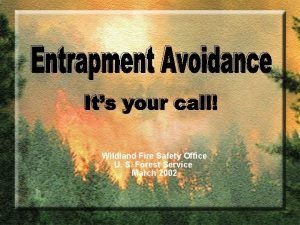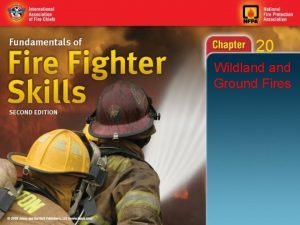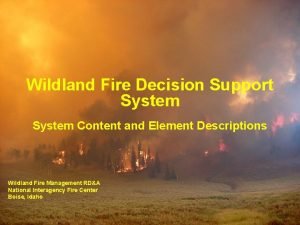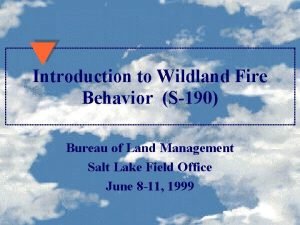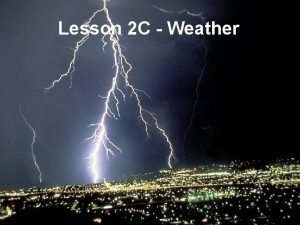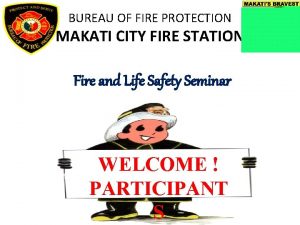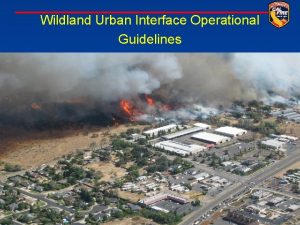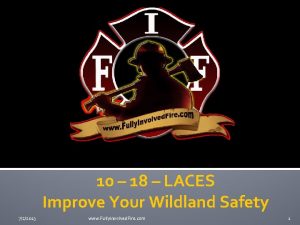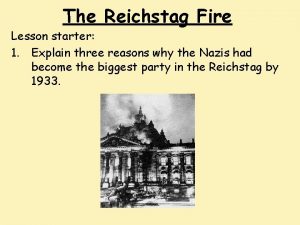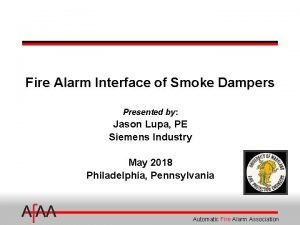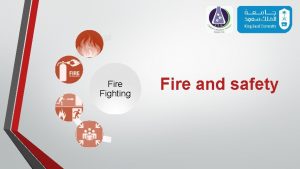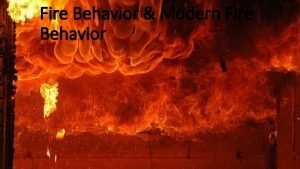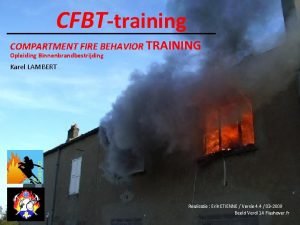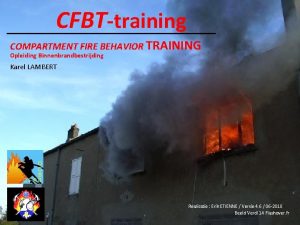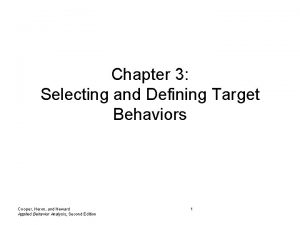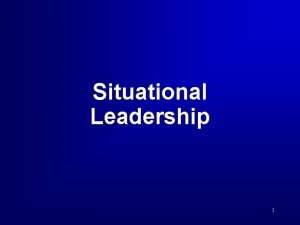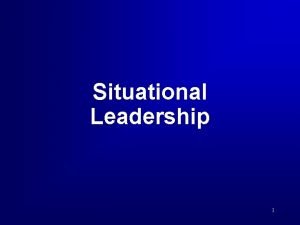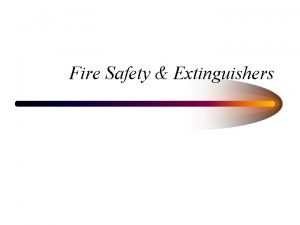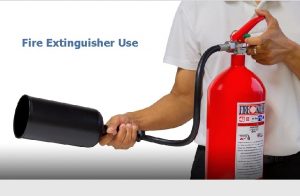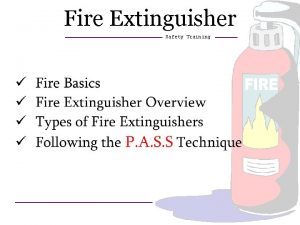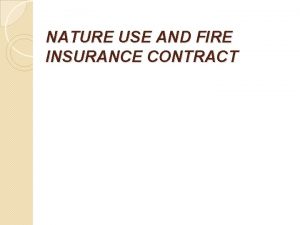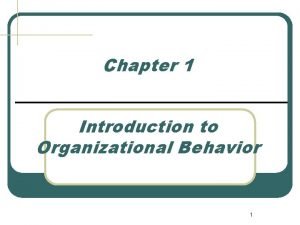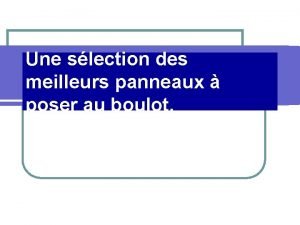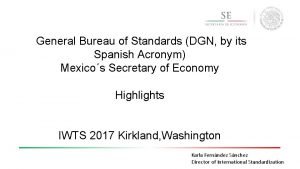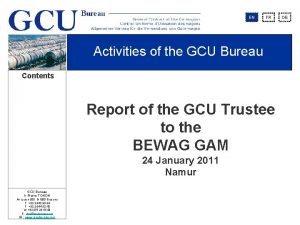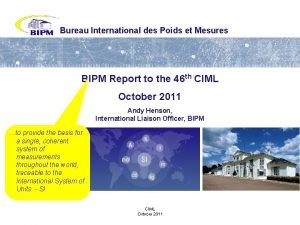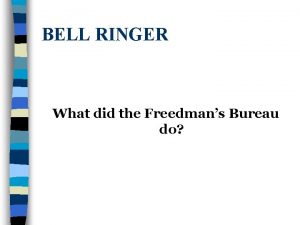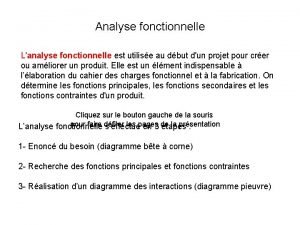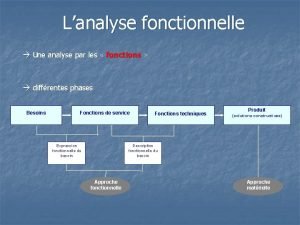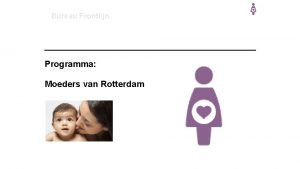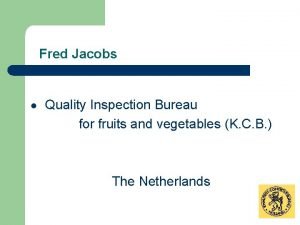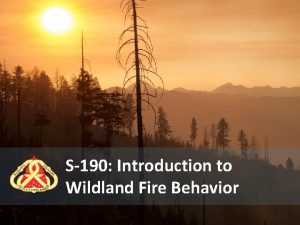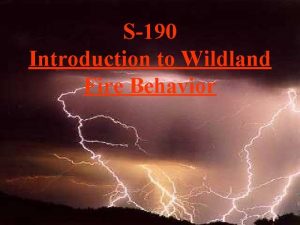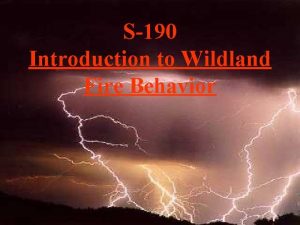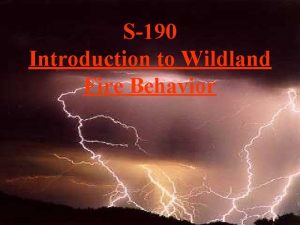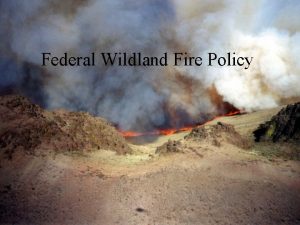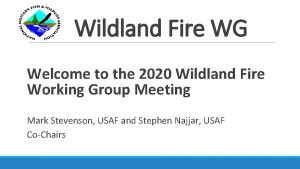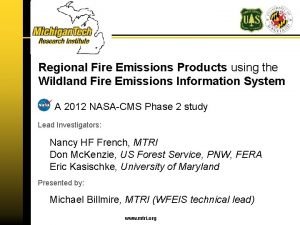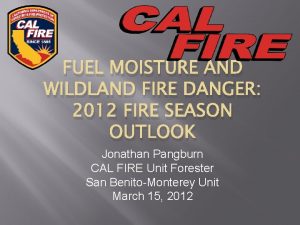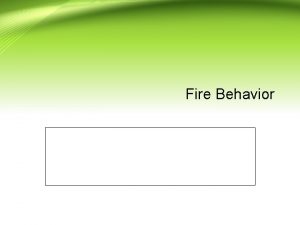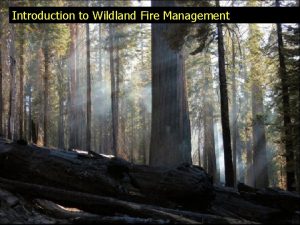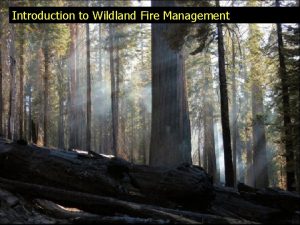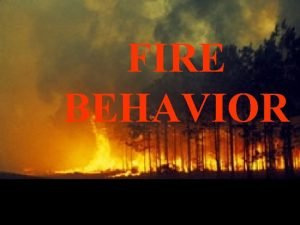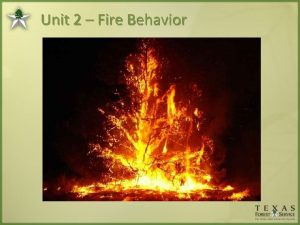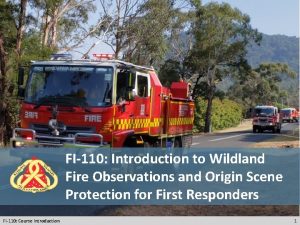Introduction to Wildland Fire Behavior S190 Bureau of

Introduction to Wildland Fire Behavior (S-190) Bureau of Land Management Salt Lake Field Office June 8 -11, 1999

COURSE OBJECTIVES u Identify and discuss the three sides of the fire triangle. u Identify the environmental factors of wildland fire behavior that affect the start and spread of wildland fire. u Recognize situations that indicate problem or extreme wildland fire behavior.

UNIT 1 OBJECTIVES u Describe the fire triangle. u Identify three methods of heat transfer. u List the three principle environmental elements affecting wildland fire behavior. u List three factors of fuel that affect the start and spread of wildland fire. u List three factors of weather that affect fuel moisture.

UNIT 1 OBJECTIVES (cont’d) u Describe how wind affects wildland fire spread. u Describe how slope affects wildland fire spread. u List four factors of topography that affect wildland fire behavior. u Describe the dangerous conditions that can develop in a box canyon and steep narrow canyons.

Fire Triangle

Heat Transfer u Radiation u Convection u Conduction

Group 1 -- Fuels u Fuel Moisture u Size and Shape (light fuels vs. heavy fuels) u Fuel Loading u Horizontal Continuity (uniform and patchy) u Vertical Arrangement (ground, surface, aerial)

Fuel Types u Grass u Shrub u Timber Litter u Logging Slash

Fuel Characteristics u Fuel Moisture u Size and Shape u Fuel Loading u Horizontal Continuity u Vertical Arrangement

Fuel Moisture The amount of water in a fuel expressed as a percentage of the oven-dry weight of that fuel.

Categories of Fuel Light Fuels: ã Leaves ã Grass ã Shrubs Heavy Fuels: ã Limbs ã Logs ã Stumps

Fuel Loading The quantity of fuels in an area.

Horizontal Continuity and Vertical Arrangement Horizontal Continuity: ã Uniform ã Patchy Vertical Arrangement: ã Ground ã Surface ã Aerial

Uniform Fuels

Patchy Fuels

Vertical Arrangement of Fuels

Group 2 -- Weather u u Temperature Wind – – – u Increases supply of oxygen. Drives convective heat into adjacent fuels. Influences direction of spread and spotting. Carries away moist air replacing it with drier air. Dries fuels. Raises fuel moisture if the air contains moisture. Relative Humidity – As RH increases, fuel moisture increases. u Precipitation – Increases fuel moisture

Group 3 -- Topography u Aspect u Slope – Steepness u Position of Fire – Top, middle, or bottom of slope u Shape of Country – Narrow canyons and box canyons u Elevation – Relates to curing of fuels, precipitation, length of fire season, etc.

Aspect NORTH Heavy fuels Shade Moist SOUTH Light fuels Sunny Dry

Steep Slopes Cause Rapid Fire Spread Convection and Radiant Heat Flame is closer to fuel

Position of Fire on Slope FIRE NEAR TOP OF SLOPE FIRE NEAR BOTTOM OF SLOPE HAS RAPID SPREAD UPSLOPE

Box Canyon & Chimney Effect

Radiant Heat Across Narrow Canyon

Spotting Across Narrow Canyon

Lateral Ridge to Canyon

Mountains Cause Channelling of Wind

Elevation TREES SHRUBS GRASS SEA LEVEL

UNIT 1 OBJECTIVES u Describe the fire triangle. u Identify three methods of heat transfer. u List the three principle environmental elements affecting wildland fire behavior. u List three factors of fuel that affect the start and spread of wildland fire. u List three factors of weather that affect fuel moisture.

UNIT 1 OBJECTIVES (cont’d) u Describe how wind affects wildland fire spread. u Describe how slope affects wildland fire spread. u List four factors of topography that affect wildland fire behavior. u Describe the dangerous conditions that can develop in a box canyon and steep narrow canyons.


UNIT 2 OBJECTIVES u List the indicators of an approaching cold front and describe what wind changes to expect. u List three common foehn wind conditions and the areas in which they occur. u Identify a thunderstorm and describe how and when it is dangerous.

UNIT 2 OBJECTIVES (cont’d) u Describe the daily cycle of slope and valley winds. u Describe the effect relative humidity has on wildland fire behavior. u Identify the wildland fire environment indicators that can produce problem and extreme fire behavior.

General or Gradient Winds Large scale winds caused by high and low pressure systems, but generally influenced and modified in the lower atmosphere by terrain.

Cold Front A cold front is the boundary line between a cooler air mass which is replacing a warmer air mass.

Cold Front Winds

Indicators of a Cold Front Passage Line of cumulus clouds approaching from the west or northwest. u Large clouds of dust can precede the arrival of a cold front. u Shift in winds from the southeast, south, to the southwest, and increase in velocity. u Winds will be strongest, erratic, and gusty as the front reaches you. u Winds will continue to shift as the front passes, generally resulting in strong, gusty, cool winds out of the west and northwest. u

Cold Fronts are Potentially Dangerous u Wind direction will abruptly change. u Strong southerly winds ahead of front will drive the fire head to the north or northeast. u Winds shifting to west or northwest after front passes will drive fire head to the east or southeast. u Rapid drop in relative humidity within 24 hours of front passage.

Fire Before Cold Front Passage

Fire After Cold Front Passage

Foehn Wind A dry wind with strong downward components, characteristic of mountainous regions.

Examples of Foehn Winds

Thunderstorm A storm produced by a cumulonimbus cloud and always accompanied by lightning, thunder, and strong gusty wind.

Visual Indicators of Thunderstorm u Tall building cumulus cloud. u Cauliflower appearance of cloud. u Dark flat base. u Virga or rain falling from bottom of cloud. u Ice crystal top usually in anvil shape with fuzzy appearance.

Thunderstorm

Why a Thunderstorm is Dangerous u Produces strong, gusty surface winds affecting direction of fire spread. u Downdraft winds will be erratic but always away from the thunderstorm. u Thunderstorms also produce lightning which can be dangerous.

Sea Breeze Land Breeze

Slope Winds

Valley Winds

Temperature/Relative Humidity Chart Noon Midnight Noon

Visual Indicators of Unstable Air Clouds grow vertically and smoke rises to great heights Cumulus type clouds Gusty winds Good visibility Dust devils and firewhirls

Visual Indicators of Stable Air Cloud in layers, no vertical motion Stratus type clouds Smoke column drifts apart after limited rise Poor visibility in lower levels due to accumulation of haze Fog layers Steady winds

Inversion

Thermal Belt

Subsidence

Dust Devils

Firewhirls Generated by intense fires. Can pick up large burning embers and toss them far across the fireline causing spot fires.

Indicators of Problem and Extreme Fire Behavior Fuel Indicators Unusually dry fuels. u Large amount of light fuel (shrubs, grass, needles). u Fuels exposed to direct sunlight. u Fuels dried by prolonged drought. u Ladder fuels that allow a surface fire to move into the crowns of shrubs or trees. u Crown foliage dried by surface fire. u Concentration of snags. u

Indicators of Problem and Extreme Fire Behavior u Steep Topography Indicators slopes. u Chutes, saddles, and box canyons which provide conditions for “chimney effect. ” u Narrow canyons may increase fire spread by radiant heat and spotting.

Indicators of Problem and Extreme Fire Behavior u u u u Weather Indicators Strong Wind. Sudden changes in wind direction and velocity due to weather fronts. High, fast-moving clouds may indicate unusual surface winds. Unexpected calm may indicate wind shift. Thunderstorms above or close to the fire. Unusually high temperatures and low relative humidity. Dust devils and whirlwinds developing. Bent smoke column.

Indicators of Problem and Extreme Fire Behavior Indicators u u u Keep an eye on the smoke column. Indicates direction of fire spread, location of spot fires, and changes in fire intensity. Many simultaneous fires starting or smoldering fires beginning to pick up in intensity. Fire begins to torch small groups of trees or shrubs. Frequent spot fires occurring. Firewhirls beginning to develop inside the main fire. Crown fires.

UNIT 2 OBJECTIVES u List the indicators of an approaching cold front and describe what wind changes to expect. u List three common foehn wind conditions and the areas in which they occur. u Identify a thunderstorm and describe how and when it is dangerous.

UNIT 2 OBJECTIVES (cont’d) u Describe the daily cycle of slope and valley winds. u Describe the effect relative humidity has on wildland fire behavior. u Identify the wildland fire environment indicators that can produce problem and extreme fire behavior.
- Slides: 62
